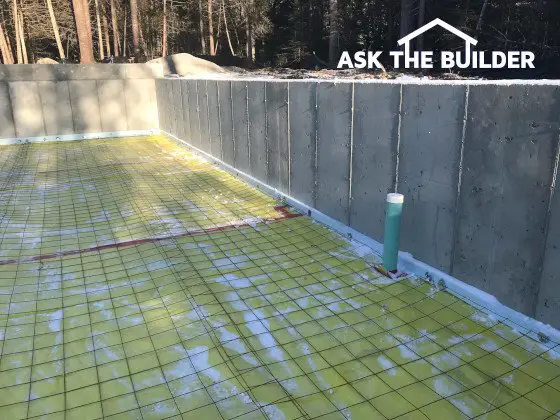Stop Water Vapor Now and Window Condensation Woes

The yellow plastic vapor retarder you see is a very special product. It’s far better than the low-priced rolls of clear plastic you might see at a home center. (C) Copyright 2018 Tim Carter
Stop Water Vapor Now
QUESTION #1: Hey Tim, I’m flummoxed. I’ve seen videos and read online articles about needing a vapor barrier in the walls of my home and possibly under concrete slabs. My builder says these things are a waste of money. I need your vote of confidence and written words to give me the strength to demand they be used. What are these materials, do they work, and where would you use them in your home? Janet A., Long Island, NY
Have you ever been rolled over by a builder, remodeler or salesperson? In the past week, it happened to my son-in-law and my son! Knowledge is power and the person with the gold makes the rules. Those are two axioms I’m continuing to pound into my kids and their spouses.
It’s very important to realize that vapor is very hard to stop. That’s why it’s best to call the products vapor retarders, not vapor barriers. I can tell you unequivocally they’re fantastic products and I’d use them in my house in certain areas all the time and in other places sometimes.
I’ve got lots of past articles and videos at my own AsktheBuilder.com website about vapor retarders and barriers, but you should also go to an authoritative website - BuildingScience.com - for some amazing facts and figures.
Another key point is to realize like other products there are different levels of quality when it comes to vapor retarders. Some products are cheap and do a so-so job of blocking vapor. If you spend a few more dollars, you can get superior products. I only buy ones that pass the ASTM E1745 test. (Read more on the ASTM E1745 products in my New High Performance Vapor Retarders column.)
Water vapor lives in the soil unless your home is in the Atacama Desert where you may find trace amounts. But normal soil is damp and the water vapor is constantly trying to get up into the air. You want to keep this vapor in the soil under your basement slab and out of your crawlspace. High-performance vapor retarders like the one above do just that. Water vapor in basements and garages can rust equipment and tools and lead to mold growth on walls.
Water vapor can cause severe wood rot in walls of modern homes. This happens primarily in cold or hot climates. You’ve surely taken a cold beverage can outdoors on a humid summer day and seen the outside surface has water drops on it in a few minutes, right? The same thing can happen in your walls where water vapor can condense on the cool surface of exterior sheathing in a cold climate or the cool surface of drywall in a hot, humid climate when you have your AC on low.
A vapor retarder placed on the correct side of an exterior wall can stop wood rot, mold and mildew. Just do a little more research and you’ll discover exactly what to do in your climate. Gather the data and don’t get rolled by your builder or remodeler. After all, it’s your money and your castle. Protect it!
Window Condensation Woes
QUESTION #2: Tim, I’m really distressed. I spent over five figures on new efficient replacement windows. I invested in the new windows because my old windows had lots of condensation streaming down the glass. I still have some condensation forming on the new ones! What’s going on and did I get ripped off? Danny S., Springfield, MA
Condensation is the bane for many a homeowner. I clearly remember the water pouring off the single-pane steel casement windows of my childhood home each winter. My mom would routinely have me towel the window sills dry in my never-ending battle with the wretched water.
It’s possible you were ripped off depending on the quality of the replacement windows you purchased. My advice to all who message me on my AsktheBuilder.com website is to purchase replacement windows that carry the gold AAMA label. Windows that have this certification are the highest quality you can get.
But here’s the rub. I could install an AAMA gold-label window in your home perfectly using the latest expanding foam insulation and you still might have condensation. Here’s why:
Condensation forms when the temperature of a surface drops below the dew point of the air touching the surface. That might make your brain hurt so here’s an example.
Imagine the outdoor temperature drops to minus 15 F one night. Even though your new windows have the best double-pane glass, the surface of the inner pane of glass in your home might drop down to 50 F while the outer pane of glass is at minus 15 F. If you have your humidifier set too high and the dew point of the air in your home is 51 F or higher, condensation is going to start to form on the glass.
The key to preventing window glass condensation is to lower the humidity in your home as the temperature drops outdoors. There are automatic controls that can do this for you.
Column 1281